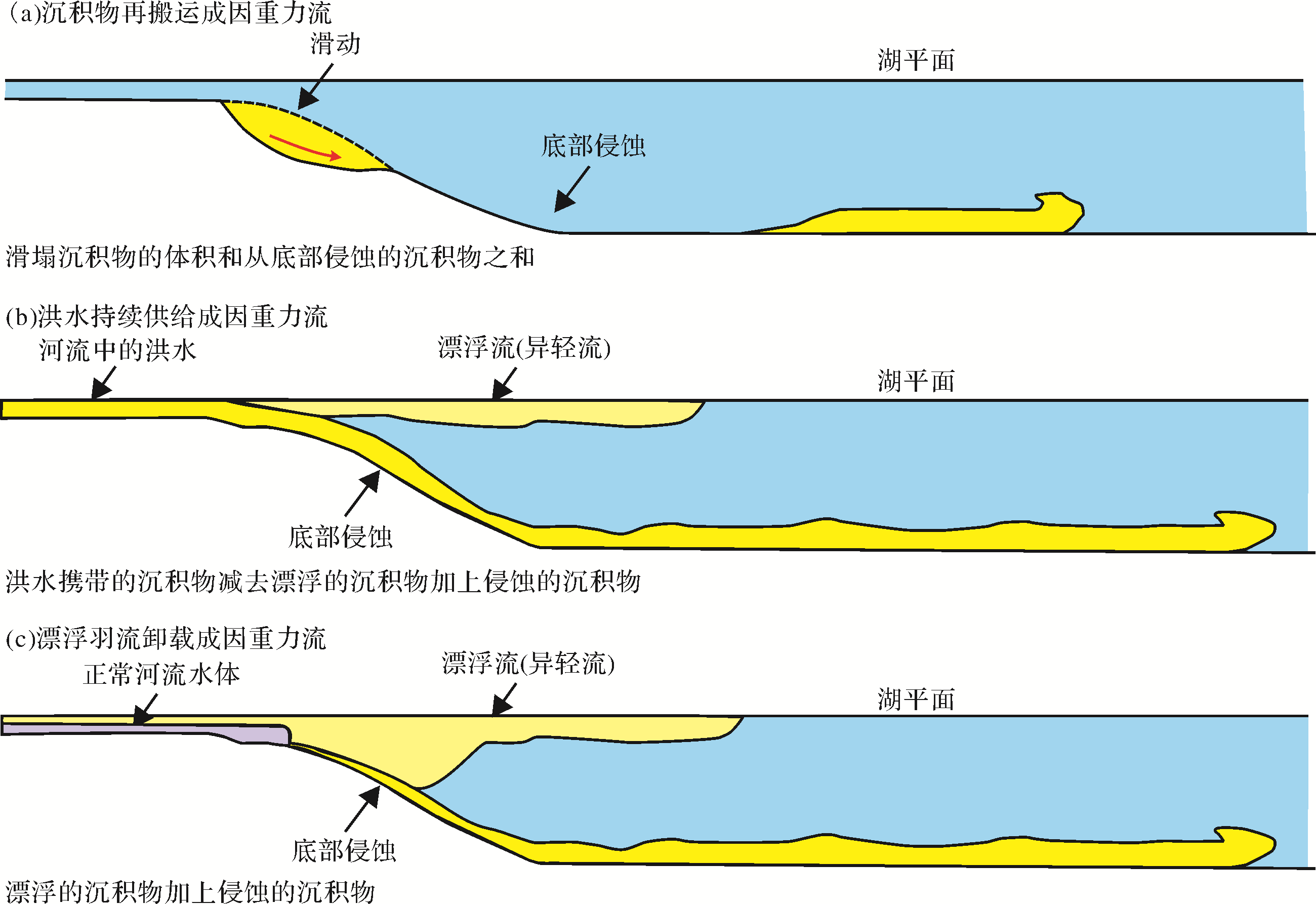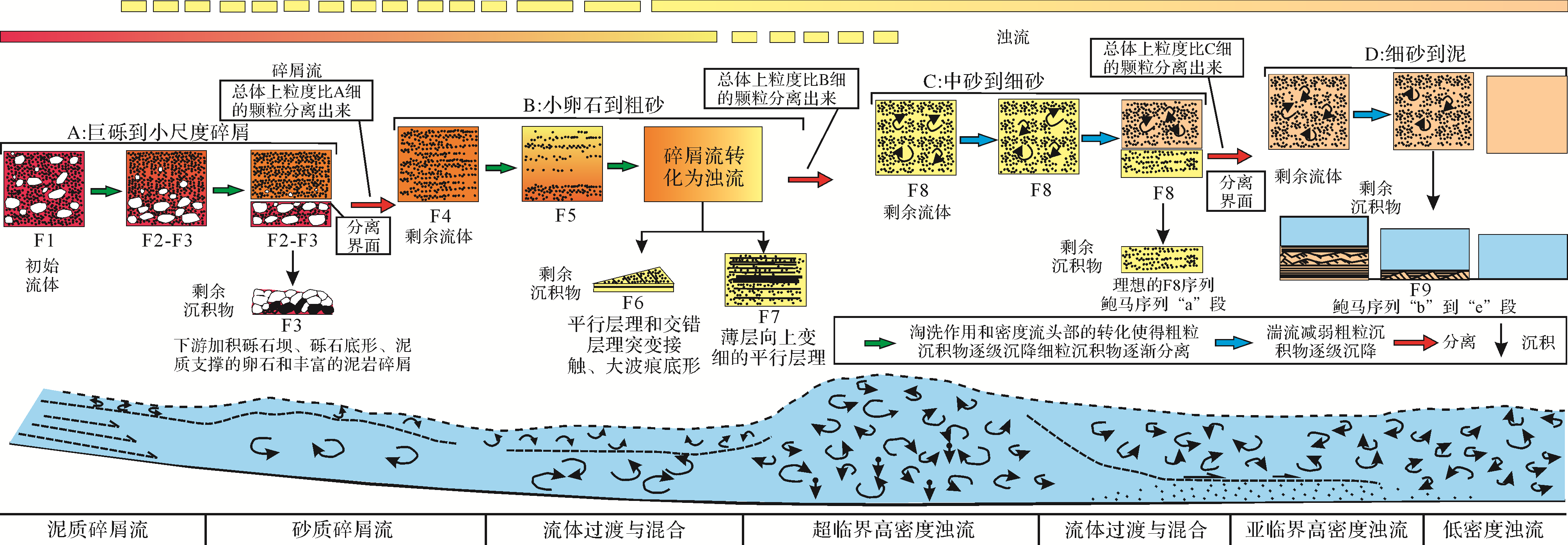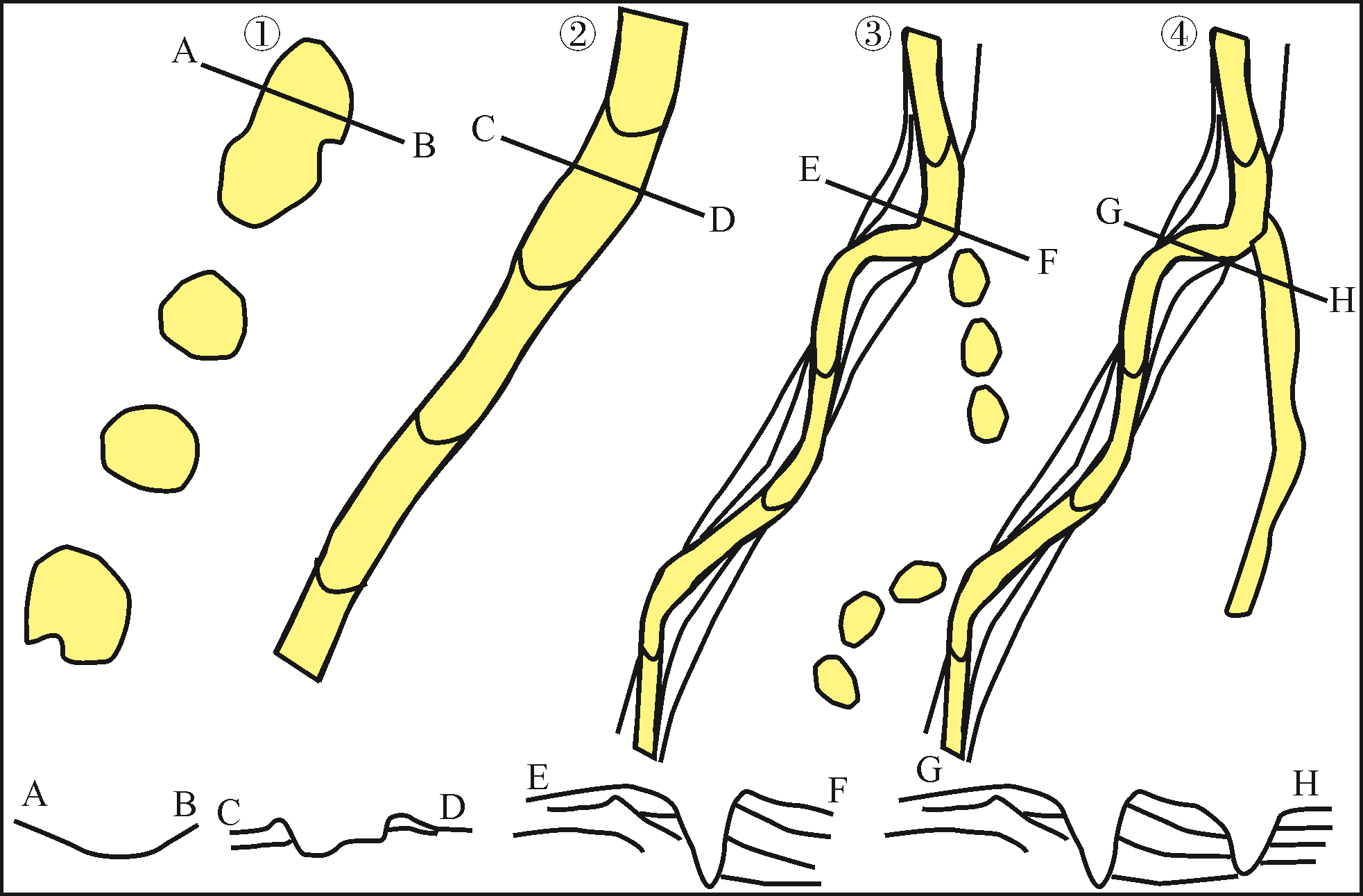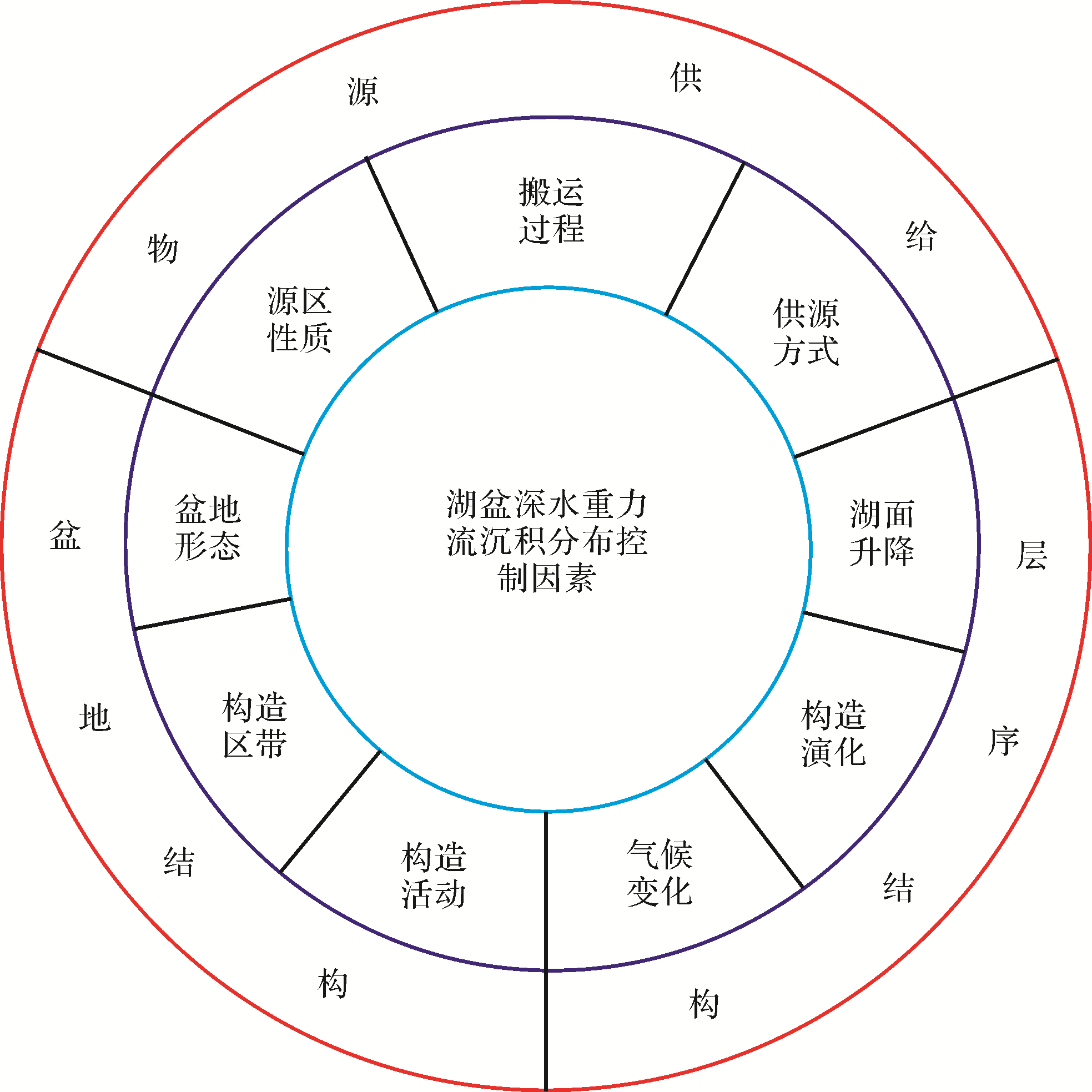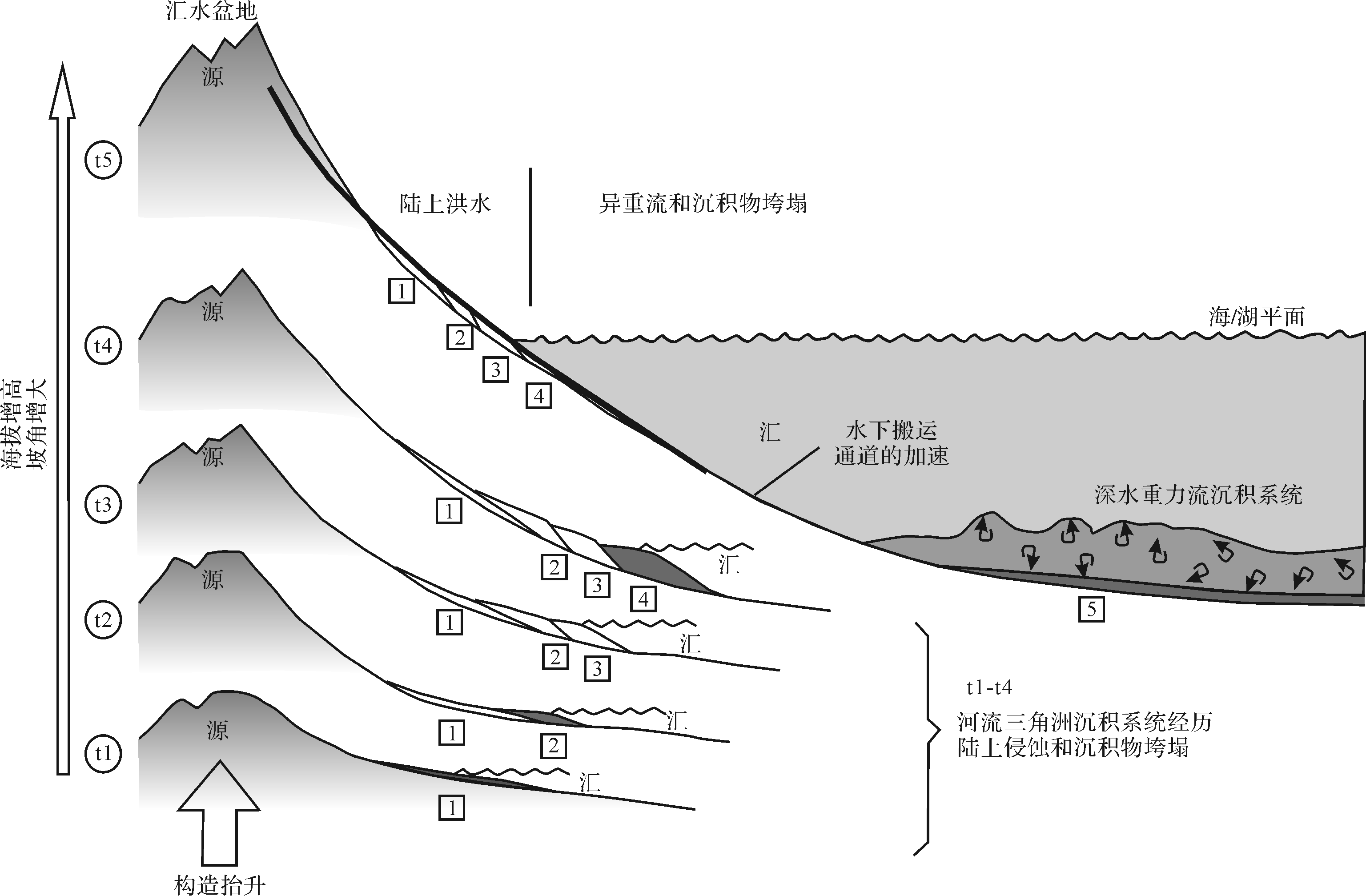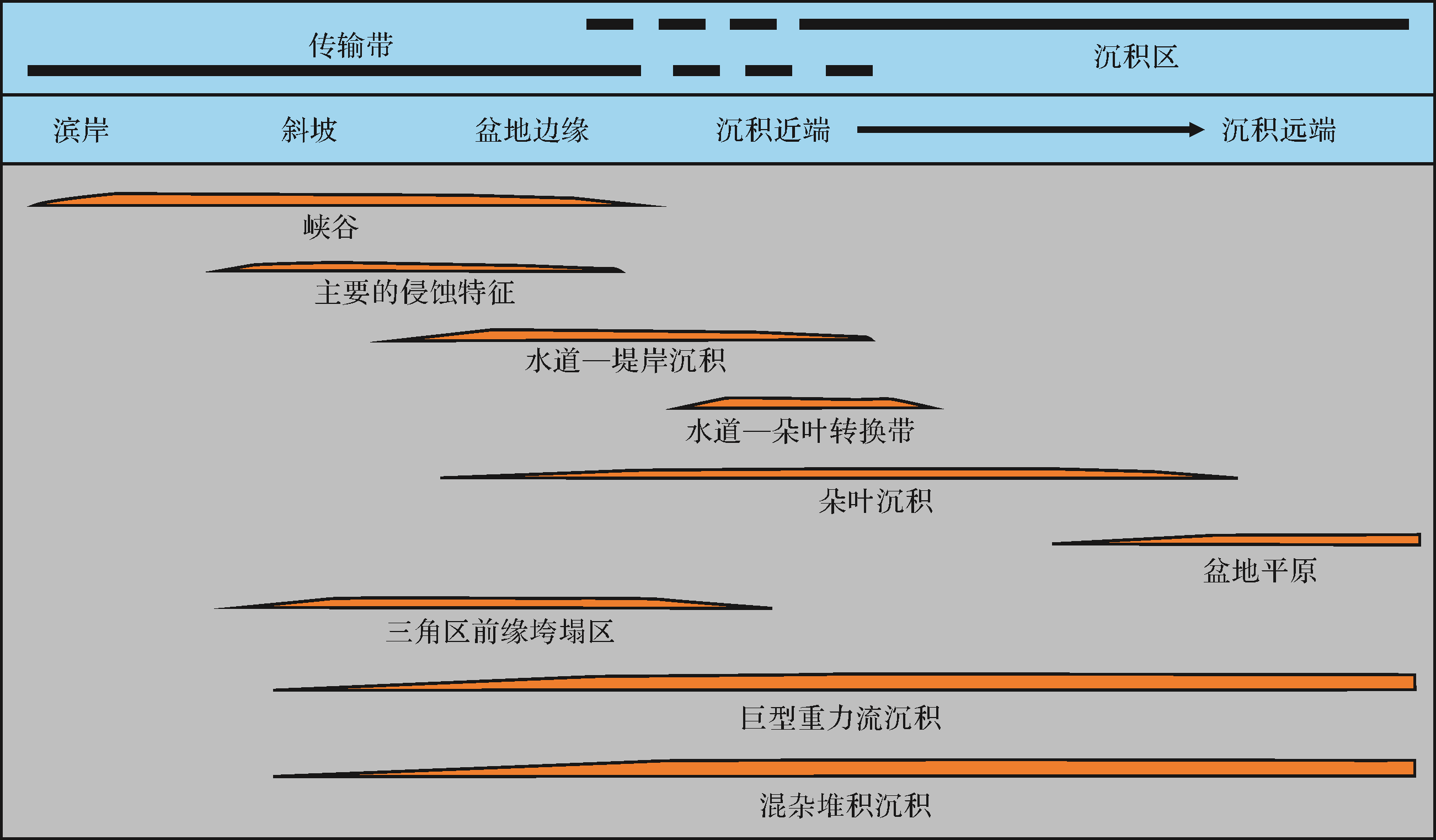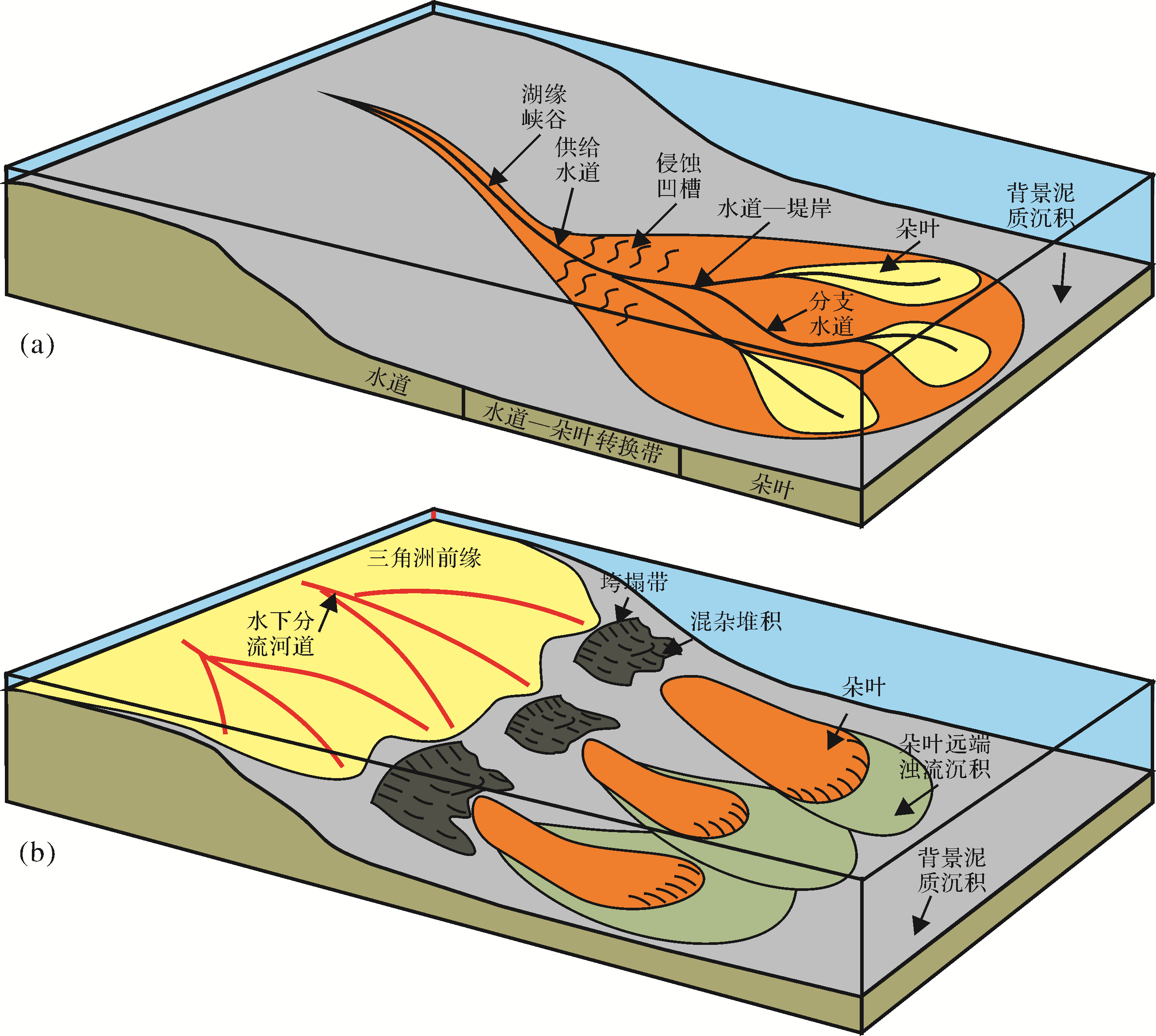| [1] |
Cao Y C, Wang Y Z, Gluyas J G, et al. Depositional model for lacustrine nearshore subaqueous fans in a rift basin: The Eocene Shahejie Formation, Dongying Sag, Bohai Bay Basin, China[J]. Sedimentology, 2018, 65(6): 2117-2148. |
| [2] |
Xian B Z, Wang J H, Gong C L, et al. Classification and sedimentary characteristics of lacustrine hyperpycnal channels: Triassic outcrops in the South Ordos Basin, central China[J]. Sedimentary Geology, 2018, 368: 68-82. |
| [3] |
Yang R C, Jin Z J, van Loon A J, et al. Climatic and tectonic controls of lacustrine hyperpycnite origination in the Late Triassic Ordos Basin, central China: Implications for unconventional petroleum development[J]. AAPG Bulletin, 2017, 101(1): 95-117. |
| [4] |
Zou C N, Wang L, Li Y, et al. Deep-lacustrine transformation of sandy debrites into turbidites, Upper Triassic, central China[J]. Sedimentary Geology, 2012, 265-266: 143-155. |
| [5] |
操应长,杨田,王艳忠,等. 超临界沉积物重力流形成演化及特征[J]. 石油学报,2017,38(6):607-621. |
Cao Yingchang, Yang Tian, Wang Yanzhong, et al. Formation, evolution and sedimentary characteristics of supercritical sediment gravity-flow[J]. Acta Petrolei Sinica, 2017, 38(6): 607-621. |
| [6] |
操应长,杨田,王艳忠,等. 深水碎屑流与浊流混合事件层类型及成因机制[J]. 地学前缘,2017,24(3):234-248. |
Cao Yingchang, Yang Tian, Wang Yanzhong, et al. Types and genesis of deep-water hybrid event beds comprising debris flow and turbidity current[J]. Earth Science Frontiers, 2017, 24(3): 234-248. |
| [7] |
蒲秀刚,周立宏,韩文中,等. 歧口凹陷沙一下亚段斜坡区重力流沉积与致密油勘探[J]. 石油勘探与开发,2014,41(2):138-149. |
Pu Xiugang, Zhou Lihong, Han Wenzhong, et al. Gravity flow sedimentation and tight oil exploration in lower first member of Shahejie Formation in slope area of Qikou Sag, Bohai Bay Basin[J]. Petroleum Exploration and Development, 2014, 41(2): 138-149. |
| [8] |
邱振,邹才能. 非常规油气沉积学:内涵与展望[J]. 沉积学报,2020,38(1):1-29. |
Qiu Zhen, Zou Caineng. Unconventional petroleum sedimentology: Connotation and prospect[J]. Acta Sedimentologica Sinica, 2020, 38(1): 1-29. |
| [9] |
宋岩,李卓,姜振学,等. 非常规油气地质研究进展与发展趋势[J]. 石油勘探与开发,2017,44(4):638-648. |
Song Yan, Li Zhuo, Jiang Zhenxue, et al. Progress and development trend of unconventional oil and gas geological research[J]. Petroleum Exploration and Development, 2017, 44(4): 638-648. |
| [10] |
杨仁超,何治亮,邱桂强,等. 鄂尔多斯盆地南部晚三叠世重力流沉积体系[J]. 石油勘探与开发,2014,41(6):661-670. |
Yang Renchao, He Zhiliang, Qiu Guiqiang, et al. Late Triassic gravity flow depositional systems in the southern Ordos Basin[J]. Petroleum Exploration and Development, 2014, 41(6): 661-670. |
| [11] |
杨田,操应长,王艳忠,等. 深水重力流类型、沉积特征及成因机制:以济阳坳陷沙河街组三段中亚段为例[J]. 石油学报,2015,36(9):1048-1059. |
Yang Tian, Cao Yingchang, Wang Yanzhong, et al. Types, sedimentary characteristics and genetic mechanisms of deep-water gravity flows: A case study of the middle submember in Member 3 of Shahejie Formation in Jiyang Depression[J]. Acta Petrolei Sinica, 2015, 36(9): 1048-1059. |
| [12] |
袁选俊,林森虎,刘群,等. 湖盆细粒沉积特征与富有机质页岩分布模式:以鄂尔多斯盆地延长组长7油层组为例[J]. 石油勘探与开发,2015,42(1):34-43. |
Yuan Xuanjun, Lin Senhu, Liu Qun, et al. Lacustrine fine-grained sedimentary features and organic-rich shale distribution pattern: A case study of Chang 7 member of Triassic Yanchang Formation in Ordos Basin, NW China[J]. Petroleum Exploration and Development, 2015, 42(1): 34-43. |
| [13] |
赵贤正,蒲秀刚,周立宏,等. 断陷湖盆深水沉积地质特征与斜坡区勘探发现:以渤海湾盆地歧口凹陷板桥—歧北斜坡区沙河街组为例[J]. 石油勘探与开发,2017,44(2):165-176. |
Zhao Xianzheng, Pu Xiugang, Zhou Lihong, et al. Geologic characteristics of deep water deposits and exploration discoveries in slope zones of fault lake basin: A case study of Paleogene Shahejie Formation in Banqiao-Qibei Slope, Qikou Sag, Bohai Bay Basin[J]. Petroleum Exploration and Development, 2017, 44(2): 165-176. |
| [14] |
朱筱敏,钟大康,袁选俊,等. 中国含油气盆地沉积地质学进展[J]. 石油勘探与开发,2016,43(5):820-829. |
Zhu Xiaomin, Zhong Dakang, Yuan Xuanjun, et al. Development of sedimentary geology of petroliferous basins in China[J]. Petroleum Exploration and Development, 2016, 43(5): 820-829. |
| [15] |
邹才能,赵政璋,杨华,等. 陆相湖盆深水砂质碎屑流成因机制与分布特征:以鄂尔多斯盆地为例[J]. 沉积学报,2009,27(6):1065-1075. |
Zou Caineng, Zhao Zhengzhang, Yang Hua, et al. Genetic mechanism and distribution of sandy debris flows in terrestrial lacustrine basin[J]. Acta Sedimentologica Sinica, 2009, 27(6): 1065-1075. |
| [16] |
Tian Y, Cao Y C, Wang Y Z, et al. Status and trends in research on deep‐ater gravity flow deposits[J]. Acta Geologica Sinica, 2015, 89(2): 610-631. |
| [17] |
Zhang X W, Scholz C A, Hecky R E, et al. Climatic control of the Late Quaternary turbidite sedimentology of Lake Kivu, East Africa: Implications for deep mixing and geologic hazards[J]. Geology, 2014, 42(9): 811-814. |
| [18] |
何起祥,刘招君,王东坡,等. 湖泊相浊积岩的主要特征及其地质意义[J]. 沉积学报,1984,2(4):33-46. |
He Qixiang, Liu Zhaojun, Wang Dongpo, et al. Characteristics of lacustrine turbidites and their tectonic significance[J]. Acta Sedimentologica Sinica, 1984, 2(4): 33-46. |
| [19] |
赖婉琦,顾家裕. 渤海湾含油气盆地中的浊积岩[J]. 沉积学报,1984,2(4):47-57. |
Lai Wanqi, Gu Jiayu. Turbidity fan in the oil and gas-bearing basin in Bohai Bay[J]. Acta Sedimentologica Sinica, 1984, 2(4): 47-57. |
| [20] |
Mulder T, Syvitski J P M, Migeon S, et al. Marine hyperpycnal flows: Initiation, behavior and related deposits. A review[J]. Marine and Petroleum Geology, 2003, 20(6/7/8): 861-882. |
| [21] |
Zavala C, Ponce J J, Arcuri M, et al. Ancient lacustrine hyperpycnites: A depositional model from a case study in the Rayoso Formation (Cretaceous) of west-central Argentina[J]. Journal of Sedimentary Research, 2006, 76(1): 41-59. |
| [22] |
王德坪,刘守义. 东营盆地渐新世早期前三角洲缓坡区的泥石流砂质碎屑沉积[J]. 沉积学报,1987,5(4):14-24. |
Wang Deping, Liu Shouyi. Debris flow sediments of sandy clastic on the gentle slope area of prodelta in Oligocene, Dongying Basin[J]. Acta Sedimentologica Sinica, 1987, 5(4): 14-24. |
| [23] |
王德坪. 湖相内成碎屑流的沉积及形成机理[J]. 地质学报,1991(4):299-316. |
Wang Deping. The sedimentation and formation mechanism of lacustrine endogenic debris flow[J]. Acta Geologica Sinica, 1991(4): 299-316. |
| [24] |
Shanmugam G. High-density turbidity currents; are they sandy debris flows?[J]. Journal of Sedimentary Research, 1996, 66(1): 2-10. |
| [25] |
李相博,刘化清,潘树新,等. 中国湖相沉积物重力流研究的过去、现在与未来[J]. 沉积学报,2019,37(5):904-921. |
Li Xiangbo, Liu Huaqing, Pan Shuxin, et al. The past, present and future of research on deep-water sedimentary gravity flow in lake basins of China[J]. Acta Sedimentologica Sinica, 2019, 37(5): 904-921. |
| [26] |
李相博,卫平生,刘化清,等. 浅谈沉积物重力流分类与深水沉积模式[J]. 地质论评,2013,59(4):607-614. |
Li Xiangbo, Wei Pingsheng, Liu Huaqing, et al. Discussion on the classification of sediment gravity flow and the deep-water sedimentary model[J]. Geological Review, 2013, 59(4): 607-614. |
| [27] |
廖纪佳,朱筱敏,邓秀芹,等. 鄂尔多斯盆地陇东地区延长组重力流沉积特征及其模式[J]. 地学前缘,2013,20(2):29-39. |
Liao Jijia, Zhu Xiaomin, Deng Xiuqin, et al. Sedimentary characteristics and model of gravity flow in Triassic Yanchang Formation of Longdong area in Ordos Basin[J]. Earth Science Frontiers, 2013, 20(2): 29-39. |
| [28] |
Zavala C, 2017: 以松辽盆地白垩系嫩江组一段为例[J]. 石油勘探与开发, 44, 860-870.
|
Pan Shuxin, Liu Huaqing, Zavala C, et al. Sublacustrine hyperpycnal channel-fan system in a large depression basin: A case study of Nen 1 member, Cretaceous Nenjiang Formation in the Songliao Basin, NE China[J]. Petroleum Exploration and Development, 2017, 44(6): 860-870. |
| [29] |
鲜本忠,万锦峰,姜在兴,等. 断陷湖盆洼陷带重力流沉积特征与模式:以南堡凹陷东部东营组为例[J]. 地学前缘,2012,19(1):121-135. |
Xian Benzhong, Wan Jinfeng, Jiang Zaixing, et al. Sedimentary characteristics and model of gravity flow deposition in the depressed belt of rift lacustrine basin: A case study from Dongying Formation in Nanpu Depression[J]. Earth Science Frontiers, 2012, 19(1): 121-135. |
| [30] |
杨仁超,金之钧,孙冬胜,等. 鄂尔多斯晚三叠世湖盆异重流沉积新发现[J]. 沉积学报,2015,33(1):10-20. |
Yang Renchao, Jin Zhijun, Sun Dongsheng, et al. Discovery of hyperpycnal flow deposits in the Late Triassic lacustrine Ordos Basin[J]. Acta Sedimentologica Sinica, 2015, 33(1): 10-20. |
| [31] |
杨田,操应长,王艳忠,等. 异重流沉积动力学过程及沉积特征[J]. 地质论评,2015,61(1):23-33. |
Yang Tian, Cao Yingchang, Wang Yanzhong, et al. Sediment dynamics process and sedimentary characteristics of hyperpycnal flows[J]. Geological Review, 2015, 61(1): 23-33. |
| [32] |
鲜本忠,王璐,刘建平,等. 东营凹陷东部始新世三角洲供给型重力流沉积特征与模式[J]. 中国石油大学学报(自然科学版),2016,40(5):10-21. |
Xian Benzhong, Wang Lu, Liu Jianping, et al. Sedimentary characteristics and model of delta-fed turbidites in Eocene eastern Dongying Depression[J]. Journal of China University of Petroleum, 2016, 40(5): 10-21. |
| [33] |
袁静,梁绘媛,梁兵,等. 湖相重力流沉积特征及发育模式:以苏北盆地高邮凹陷深凹带戴南组为例[J]. 石油学报,2016,37(3):348-359. |
Yuan Jing, Liang Huiyuan, Liang Bing, et al. Sedimentary characteristics and development model of lacustrine gravity flow: A case study of Dainan Formation in deep sag belt of Gaoyou Depression, northern Jiangsu Basin[J]. Acta Petrolei Sinica, 2016, 37(3): 348-359. |
| [34] |
周立宏,陈长伟,韩国猛,等. 断陷湖盆异重流沉积特征与分布模式:以歧口凹陷板桥斜坡沙一下亚段为例[J]. 中国石油勘探,2018,23(4):11-20. |
Zhou Lihong, Chen Changwei, Han Guomeng, et al. Sedimentary characteristics and distribution patterns of hyperpycnal flow in rifted lacustrine basins: A case study on lower Es1 of Banqiao slope in Qikou Sag[J]. China Petroleum Exploration, 2018, 23(4): 11-20. |
| [35] |
Talling P J, Masson D G, Sumner E J, et al. Subaqueous sediment density flows: Depositional processes and deposit types[J]. Sedimentology, 2012, 59(7): 1937-2003. |
| [36] |
宋明水,向奎,张宇,等. 泥质重力流沉积研究进展及其页岩油气地质意义:以东营凹陷古近系沙河街组三段为例[J]. 沉积学报,2017,35(4):740-751. |
Song Mingshui, Xiang Kui, Zhang Yu, et al. Research progresses on muddy gravity flow deposits and their significances on shale oil and gas: A case study from the 3rd oil-member of the Paleogene Shahejie Formation in the Dongying Sag[J]. Acta Sedimentologica Sinica, 2017, 35(4): 740-751. |
| [37] |
谈明轩,朱筱敏,耿名扬,等. 沉积物重力流流体转化沉积—混合事件层[J]. 沉积学报,2016,34(6):1108-1119. |
Tan Mingxuan, Zhu Xiaomin, Geng Mingyang, et al. The flow transforming deposits of sedimentary gravity flow-hybrid event bed[J]. Acta Sedimentologica Sinica, 2016, 34(6): 1108-1119. |
| [38] |
谈明轩,朱筱敏,刘伟,等. 旋回阶梯底形的动力地貌及其相关沉积物发育特征[J]. 地质论评,2017,63(6):1512-1522. |
Tan Mingxuan, Zhu Xiaomin, Liu Wei, et al. The morphodynamics of cyclic steps and sedimentary characteristics of associated deposits[J]. Geological Review, 2017, 63(6): 1512-1522. |
| [39] |
杨仁超,尹伟,樊爱萍,等. 鄂尔多斯盆地南部三叠系延长组湖相重力流沉积细粒岩及其油气地质意义[J]. 古地理学报,2017,19(5):791-806. |
Yang Renchao, Yin Wei, Fan Aiping, et al. Fine-grained, lacustrine gravity-flow deposits and their hydrocarbon significance in the Triassic Yanchang Formation in southern Ordos Basin[J]. Journal of Palaeogeography, 2017, 19(5): 791-806. |
| [40] |
Gilluly J. Geologic contrasts between continents and ocean basins[M]//Poldervaart A. Crust of the earth: A symposium. New York: Geological Society of America, 1955: 7-18. |
| [41] |
Zhang X W, Scholz C A. Turbidite systems of lacustrine rift basins: Examples from the Lake Kivu and Lake Albert rifts, East Africa[J]. Sedimentary Geology, 2015, 325: 177-191. |
| [42] |
Katz B J. Lacustrine basin hydrocarbon exploration–current thoughts[J]. Journal of Paleolimnology, 2001, 26(2): 161-179. |
| [43] |
Katz B J, Liu X C. Summary of the AAPG research symposium on lacustrine basin exploration in China and Southeast Asia[J]. AAPG Bulletin, 1998, 82(7): 1300-1307. |
| [44] |
Dodd T J H, McCarthy D J, Richards P C. A depositional model for deep‐lacustrine, partially confined, turbidite fans: Early Cretaceous, North Falkland Basin[J]. Sedimentology, 2019, 66(1): 53-80. |
| [45] |
Fongngern R, Olariu C, Steel R, et al. Subsurface and outcrop characteristics of fluvial‐dominated deep‐lacustrine clinoforms[J]. Sedimentology, 2018, 65(5): 1447-1481. |
| [46] |
刘芬,朱筱敏,李洋,等. 鄂尔多斯盆地西南部延长组重力流沉积特征及相模式[J]. 石油勘探与开发,2015,42(5):577-588. |
Liu Fen, Zhu Xiaomin, Li Yang, et al. Sedimentary characteristics and facies model of gravity flow deposits of Late Triassic Yanchang Formation in southwestern Ordos Basin, NW China[J]. Petroleum Exploration and Development, 2015, 42(5): 577-588. |
| [47] |
Kremer K, Corella J P, Adatte T, et al. Origin of turbidites in deep Lake Geneva (France⁃Switzerland) in the last 1500 years[J]. Journal of Sedimentary Research, 2015, 85(12): 1455-1465. |
| [48] |
Nelson C H, Escutia C, Goldfinger C, et al. External controls on modern clastic turbidite systems: Three case studies[M]//Kneller B, Martinsen O J, McCaffrey B. External controls on deep water depositional systems: Climate, sea-level, and sediment flux. Tulsa: SEPM Special Publication, 2009: 57-76. . |
| [49] |
Feng Z Q, Zhang S, Cross T A, et al. Lacustrine turbidite channels and fans in the Mesozoic Songliao Basin, China[J]. Basin Research, 2010, 22(1): 96-107. |
| [50] |
Dasgupta P. Sediment gravity flow—the conceptual problems[J]. Earth-Science Reviews, 2003, 62(3/4): 265-281. |
| [51] |
李祥辉,王成善,金玮,等. 深海沉积理论发展及其在油气勘探中的意义[J]. 沉积学报,2009,27(1):77-86. |
Li Xianghui, Wang Chengshan, Jin Wei, et al. A review on deep-sea sedimentation theory: Significances to oil-gas exploration[J]. Acta Sedimentologica Sinica, 2009, 27(1): 77-86. |
| [52] |
梁建设,田兵,王琪,等. 深水沉积理论研究现状、存在问题及发展趋势[J]. 天然气地球科学,2017,28(10):1488-1496. |
Liang Jianshe, Tian Bing, Wang Qi, et al. Research review, existing problems and future direction of deepwater sedimentary theory[J]. Natural Gas Geoscience, 2017, 28(10): 1488-1496. |
| [53] |
Middleton G V, Hampton M A. Sediment gravity flows: Mechanics of flow and deposition[M]//Middleton G V, Bouma A H. Turbidites and deep-water sedimentation: Short course lecture notes, Part I. Los Angeles: AAPG, 1973. |
| [54] |
何起祥. 沉积动力学若干问题的讨论[J]. 海洋地质与第四纪地质,2010,30(4):1-10. |
He Qixiang. A discussion on sediment dynamics[J]. Marine Geology & Quaternary Geology, 2010, 30(4): 1-10. |
| [55] |
吴因业,张天舒,冯荣昌,等. 四川侏罗系半深湖环境的超临界流浊积砂体沉积特征[C]//2015年全国沉积学大会沉积学与非常规资源论文摘要集. 武汉:中国地质学会沉积地质专业委员会,中国矿物岩石地球化学学会沉积学专业委员会,2015:2. [ |
Wu Yinye, Zhang Tianshu, Feng Rongchang, et al. The sedimentary characteristics of supercritical turbidite sand bodies in semi-deep lake environment of Jurassic in Sichuan province[C]//2015 China national conference of sedimentology. Wuhan: Professional Committee of Sedimentary Geology, Chinese Geological Society, Professional Committee of Sedimentology, Chinese Society of Mineralogy and Petrochemistry, 2015: 2.] |
| [56] |
李相博,刘化清,完颜容,等. 鄂尔多斯盆地三叠系延长组砂质碎屑流储集体的首次发现[J]. 岩性油气藏,2009,21(4):19-21. |
Li Xiangbo, Liu Huaqing, Wanyan Rong, et al. First discovery of the sandy debris flow from the Triassic Yanchang Formation, Ordos Basin[J]. Lithologic Reservoirs, 2009, 21(4): 19-21. |
| [57] |
耳闯,顾家裕,牛嘉玉,等. 重力驱动作用:滦平盆地下白垩统西瓜园组沉积时期主要的搬运机制[J]. 地质论评,2010,56(3):312-320. |
Chuang Er, Gu Jiayu, Niu Jiayu, et al. Gravity-driven processes: A more important transport mechanism of deposits in Xiguayuan Formation of Lower Cretaceous in Luanping Basin, northern Hebei[J]. Geological Review, 2010, 56(3): 312-320. |
| [58] |
潘树新,郑荣才,卫平生,等. 陆相湖盆块体搬运体的沉积特征、识别标志与形成机制[J]. 岩性油气藏,2013,25(2):9-18, 25. |
Pan Shuxin, Zheng Rongcai, Wei Pingsheng, et al. Deposition characteristics, recognition mark and form mechanism of mass transport deposits in terrestrial lake basin[J]. Lithologic Reservoirs, 2013, 25(2): 9-18, 25. |
| [59] |
Shanmugam G. New perspectives on deep-water sandstones: Implications[J]. Petroleum Exploration and Development, 2013, 40(3): 316-324. |
| [60] |
Lowe D R. Sediment gravity flows: II, depositional models with special reference to the deposits of high-density turbidity currents[J]. Journal of Sedimentary Research, 1982, 52(1): 279-297. |
| [61] |
金杰华,操应长,王健,等. 深水砂质碎屑流沉积:概念、沉积过程与沉积特征[J]. 地质论评,2019,65(3):689-702. |
Jin Jiehua, Cao Yingchang, Wang Jian, et al. Deep-water sandy debris flow deposits: Concepts, sedimentary processes and characteristics[J]. Geological Review, 2019, 65(3): 689-702. |
| [62] |
裴羽,何幼斌,李华,等. 高密度浊流和砂质碎屑流关系的探讨[J]. 地质论评,2015,61(6):1281-1292. |
Pei Yu, He Youbin, Li Hua, et al. Discuss about relationship between high-density turbidity current and sandy debris flow[J]. Geological Review, 2015, 61(6): 1281-1292. |
| [63] |
Kuenen P H, Migliorini C I. Turbidity currents as a cause of graded bedding[J]. The Journal of Geology, 1950, 58(2): 91-127. |
| [64] |
李存磊,张金亮,宋明水,等. 基于沉积相反演的砂砾岩体沉积期次精细划分与对比:以东营凹陷盐家地区古近系沙四段上亚段为例[J]. 地质学报,2011,85(6):1008-1018. |
Li Cunlei, Zhang Jinliang, Song Mingshui, et al. Fine division and correlation of glutenite sedimentary periods based on sedimentary facies inversion: A case study from the Paleogene strata of Upper Es4 in the Yanjia area, Dongying Depression[J]. Acta Geologica Sinica, 2011, 85(6): 1008-1018. |
| [65] |
Hughes Clarke J E. First wide-angle view of channelized turbidity currents links migrating cyclic steps to flow characteristics[J]. Nature Communications, 2016, 7(1): 11896. |
| [66] |
Bates C C. Rational theory of delta formation[J]. AAPG Bulletin, 1953, 37(9): 2119-2162. |
| [67] |
Mulder T, Syvitski J P M. Turbidity currents generated at river mouths during exceptional discharges to the world oceans[J]. The Journal of Geology, 1995, 103(3): 285-299. |
| [68] |
Yuan J, Yu G D, Song M S, et al. Depositional characteristics and reservoir potential of Paleogene sediment gravity flow deposits on a faulted slope of the Zhanhua Sag, Bohai Bay Basin, China[J]. Journal of Asian Earth Sciences, 2019, 177: 89-106. |
| [69] |
金杰华,操应长,王健,等. 涠西南凹陷陡坡带流一段上亚段异重流沉积新发现[J]. 地学前缘,2019,26(4):250-258. |
Jin Jiehua, Cao Yingchang, Wang Jian, et al. New discovery of hyperpycnal flow deposits in the section of the steep slope belt in the Weixinan Sag[J]. Earth Science Frontiers, 2019, 26(4): 250-258. |
| [70] |
谈明轩,朱筱敏,朱世发. 异重流沉积过程和沉积特征研究[J]. 高校地质学报,2015,21(1):94-104. |
Tan Mingxuan, Zhu Xiaomin, Zhu Shifa. Research on sedimentary process and characteristics of hyperpycnal flows[J]. Geological Journal of China Universities, 2015, 21(1): 94-104. |
| [71] |
Mulder T, Chapron E. Flood deposits in continental and marine environments: Character and significance[M]//Slatt R M, Zavala C. Sediment transfer from shelf to deep water—revisiting the delivery system:AAPG studies in geology. Tulsa: APPG, 2011: 1-30. |
| [72] |
Zavala C. The new knowledge is written on sedimentary rocks⁃a comment on Shanmugam’s paper “the hyperpycnite problem”[J]. Journal of Palaeogeography, 2019, 8(1): 23. |
| [73] |
Haughton P, Davis C, McCaffrey W, et al. Hybrid sediment gravity flow deposits–classification, origin and significance[J]. Marine and Petroleum Geology, 2009, 26(10): 1900-1918. |
| [74] |
Talling P J. Hybrid submarine flows comprising turbidity current and cohesive debris flow: Deposits, theoretical and experimental analyses, and generalized models[J]. Geosphere, 2013, 9(3): 460-488. |
| [75] |
Felix M, Peakall J. Transformation of debris flows into turbidity currents: Mechanisms inferred from laboratory experiments[J]. Sedimentology, 2006, 53(1): 107-123. |
| [76] |
Hovikoski J, Therkelsen J, Nielsen L H, et al. Density-flow deposition in a fresh-water lacustrine rift basin, Paleogene Bach Long Vi Graben, Vietnam[J]. Journal of Sedimentary Research, 2016, 86(9): 982-1007. |
| [77] |
Williams L S. Sedimentology of the Lower Cretaceous reservoirs of the Sea Lion Field, North Falkland Basin[J]. Petroleum Geoscience, 2015, 21(2/3): 183-198. |
| [78] |
Parker G, Garcia M, Fukushima Y, et al. Experiments on turbidity currents over an erodible bed[J]. Journal of Hydraulic Research, 1987, 25(1): 123-147. |
| [79] |
Postma G, Cartigny M J B. Supercritical and subcritical turbidity currents and their deposits: A synthesis[J]. Geology, 2014, 42(11): 987-990. |
| [80] |
Normandeau A, Lajeunesse P, Poiré A G, et al. Morphological expression of bedforms formed by supercritical sediment density flows on four Fjord‐Lake deltas of the south‐eastern Canadian Shield (eastern Canada)[J]. Sedimentology, 2016, 63(7): 2106-2129. |
| [81] |
Jin Q, Wang R, Zhu G Y, et al. The lacustrine liangjialou fan in the Dongying depression, eastern China: Deep‐water reservoir sandstones in a Non‐Marine Rift Basin[J]. Journal of Petroleum Geology, 2005, 28(4): 397-412. |
| [82] |
Wang J D, Li S Z, Santosh M, et al. Lacustrine turbidites in the Eocene Shahejie Formation, Dongying Sag, Bohai Bay Basin, North China Craton[J]. Geological Journal, 2013, 48(5): 561-578. |
| [83] |
王伟锋,胡瑜,于正军,等. 东营三角洲前缘坡移扇储集体特征及成因研究[J]. 石油实验地质,2016,38(5):600-608. |
Wang Weifeng, Hu Yu, Yu Zhengjun, et al. Reservoir characteristics and genesis of slope fans in Dongying delta front[J]. Petroleum Geology & Experiment, 2016, 38(5): 600-608. |
| [84] |
鄢继华,陈世悦,宋国奇,等. 三角洲前缘滑塌浊积岩形成过程初探[J]. 沉积学报,2004,22(4):573-578. |
Yan Jihua, Chen Shiyue, Song Guoqi, et al. Preliminary study on the formation of fluxoturbidite in front of delta[J]. Acta Sedimentologica Sinica, 2004, 22(4): 573-578. |
| [85] |
鄢继华,陈世悦,姜在兴. 东营凹陷北部陡坡带近岸水下扇沉积特征[J]. 石油大学学报(自然科学版),2005,29(1):12-16,21. |
Yan Jihua, Chen Shiyue, Jiang Zaixing. Sedimentary characteristics of nearshore subaqueous fans in steep slope of Dongying Depression[J]. Journal of the University of Petroleum, China, 2005, 29(1): 12-16, 21. |
| [86] |
隋风贵,罗佳强,郝雪峰,等. 东营中央洼陷带缓坡远岸浊积扇体系序列及其含油气性[J]. 矿物岩石,2003,23(3):76-81. |
Fenggui Sui, Luo Jiaqiang, Hao Xuefeng, et al. The sequence of far-shore turbidite fan systems on gentle slope and its petroleum-bearing feature in central depression belt of Dongying[J]. Journal of Mineralogy and Petrology, 2003, 23(3): 76-81. |
| [87] |
张善文,曾溅辉,肖焕钦,等. 济阳坳陷岩性油气藏充满度大小及分布特征[J]. 地质论评,2004,50(4):365-369. |
Zhang Shanwen, Zeng Jianhui, Xiao Huanqin, et al. Oil-gas filling degree and distribution characteristics of the lithological oil-gas reservoir in the Jiyang Depression[J]. Geological Review, 2004, 50(4): 365-369. |
| [88] |
王留奇,姜在兴,操应长,等. 东营凹陷沙河街组断槽重力流水道沉积研究[J]. 石油大学学报(自然科学版),1994,18(3):19-25. |
Wang Liuqi, Jiang Zaixing, Cao Yingchang, et al. Sedimentation in fault-trough gravity channel at Shahejie Formation of Dongying Depression[J]. Journal of the University of Petroleum, China, 1994, 18(3): 19-25. |
| [89] |
Mutti E, Bernoulli D, Lucchi F R, et al. Turbidites and turbidity currents from Alpine ‘flysch’ to the exploration of continental margins[J]. Sedimentology, 2009, 56(1): 267-318. |
| [90] |
Shanmugam G. 50 years of the turbidite paradigm (1950s—1990s): Deep-water processes and facies models—a critical perspective[J]. Marine and Petroleum Geology, 2000, 17(2): 285-342. |
| [91] |
Talling P J. On the triggers, resulting flow types and frequencies of subaqueous sediment density flows in different settings[J]. Marine Geology, 2014, 352: 155-182. |
| [92] |
Yang T, Cao Y C, Liu K Y, et al. Genesis and depositional model of subaqueous sediment gravity-flow deposits in a lacustrine rift basin as exemplified by the Eocene Shahejie Formation in the Jiyang Depression, eastern China[J]. Marine and Petroleum Geology, 2019, 102: 231-257. |
| [93] |
Fisher R V. Flow transformations in sediment gravity flows[J]. Geology, 1983, 11(5): 273-274. |
| [94] |
Gani M R. From turbid to lucid: A straightforward approach to sediment gravity flows and their deposits[J]. The Sedimentary Record, 2004, 2: 4-8. |
| [95] |
Mutti E. Turbidite sandstones [M]. Istituto di Geologia Università di Parma, Italy, 1992: 1-256. |
| [96] |
Felix M, Leszczyński S, Ślączka A, et al. Field expressions of the transformation of debris flows into turbidity currents, with examples from the Polish Carpathians and the French Maritime Alps[J]. Marine and Petroleum Geology, 2009, 26(10): 2011-2020. |
| [97] |
Talling P J, Allin J, Armitage D A, et al. Key future directions for research on turbidity currents and their deposits[J]. Journal of Sedimentary Research, 2015, 85(2): 153-169. |
| [98] |
Talling P J, Paull C K, Piper D J W. How are subaqueous sediment density flows triggered, what is their internal structure and how does it evolve? Direct observations from monitoring of active flows[J]. Earth-Science Reviews, 2013, 125: 244-287. |
| [99] |
Yang T, Cao Y, Friis H, et al. Origin and evolution processes of hybrid event beds in the Lower Cretaceous of the Lingshan Island, eastern China[J]. Australian Journal of Earth Sciences, 2018, 65(4): 517-534. |
| [100] |
李存磊,任伟伟,唐明明. 流体性质转换机制在重力流沉积体系分析中应用初探[J]. 地质论评,2012,58(2):285-296. |
Li Cunlei, Ren Weiwei, Tang Mingming. Preliminary study on gravity flow depositional system based on fluid properties conversion theory[J]. Geological Review, 2012, 58(2): 285-296. |
| [101] |
李林,曲永强,孟庆任,等. 重力流沉积:理论研究与野外识别[J]. 沉积学报,2011,29(4):677-688. |
Li Lin, Qu Yongqiang, Meng Qingren, et al. Gravity flow sedimentation: Theoretical studies and field identification[J]. Acta Sedimentologica Sinica, 2011, 29(4): 677-688. |
| [102] |
操应长,王思佳,王艳忠,等. 滑塌型深水重力流沉积特征及沉积模式:以渤海湾盆地临南洼陷古近系沙三中亚段为例[J]. 古地理学报,2017,19(3):419-432. |
Cao Yingchang, Wang Sijia, Wang Yanzhong, et al. Sedimentary characteristics and depositional model of slumping deep-water gravity flow deposits: A case study from the middle Member 3 of Paleogene Shahejie Formation in Linnan subsag, Bohai Bay Basin[J] Journal of Palaeogeography, 2017, 19(3): 419-432. |
| [103] |
Covault J A, Kostic S, Paull C K, et al. Cyclic steps and related supercritical bedforms: Building blocks of deep-water depositional systems, western North America[J]. Marine Geology, 2017, 393: 4-20. |
| [104] |
Symons W O, Sumner E J, Talling P J, et al. Large-scale sediment waves and scours on the modern seafloor and their implications for the prevalence of supercritical flows[J]. Marine Geology, 2016, 371: 130-148. |
| [105] |
Cartigny M J B, Ventra D, Postma G, et al. Morphodynamics and sedimentary structures of bedforms under supercritical‐flow conditions: New insights from flume experiments[J]. Sedimentology, 2014, 61(3): 712-748. |
| [106] |
Normandeau A, Dietrich P, Lajeunesse P, et al. Timing and controls on the delivery of coarse sediment to deltas and submarine fans on a formerly glaciated coast and shelf[J]. GSA Bulletin, 2017, 129(11/12): 1424-1441. |
| [107] |
Covault J A, Kostic S, Paull C K, et al. Submarine channel initiation, filling and maintenance from sea‐floor geomorphology and morphodynamic modelling of cyclic steps[J]. Sedimentology, 2014, 61(4): 1031-1054. |
| [108] |
Lang J, Brandes C, Winsemann J. Erosion and deposition by supercritical density flows during channel avulsion and backfilling: Field examples from coarse-grained deepwater channel-levée complexes (Sandino Forearc Basin, southern Central America)[J]. Sedimentary Geology, 2017, 349: 79-102. |
| [109] |
Postma G, Hoyal D C, Abreu V, et al. Morphodynamics of supercritical turbidity currents in the channel-lobe transition zone[M]//Lamarche G, Mountjo J, Bull S, et al. Submarine mass movements and their consequences: 7th international symposium. Cham: Springer, 2016: 469-478. |
| [110] |
Wynn R B, Kenyon N H, Masson D G, et al. Characterization and recognition of deep-water channel-lobe transition zones[J]. AAPG Bulletin, 2002, 86(8): 1441-1462. |
| [111] |
Mohrig D, Ellis C, Parker G, et al. Hydroplaning of subaqueous debris flows[J]. GSA Bulletin, 1998, 110(3): 387-394. |
| [112] |
Ilstad T, Elverhøi A, Issler D, et al. Subaqueous debris flow behaviour and its dependence on the sand/clay ratio: A laboratory study using particle tracking[J]. Marine Geology, 2004, 213(1/2/3/4): 415-438. |
| [113] |
Kneller B C, Branney M J. Sustained high‐density turbidity currents and the deposition of thick massive sands[J]. Sedimentology, 1995, 42(4): 607-616. |
| [114] |
Hiscott R N. Traction-carpet stratification in turbidites—fact or fiction?[J]. Journal of Sedimentary Research, 1994, 64(2a): 204-208. |
| [115] |
Sohn Y K. On traction-carpet sedimentation[J]. Journal of Sedimentary Research, 1997, 67(3): 502-509. |
| [116] |
Cartigny M J B, Eggenhuisen J T, Hansen E W M, et al. Concentration-dependent flow stratification in experimental high-density turbidity currents and their relevance to turbidite facies models[J]. Journal of Sedimentary Research, 2013, 83(12): 1047-1065. |
| [117] |
Bagnold R A. Experiments on a gravity-free dispersion of large solid spheres in a Newtonian fluid under shear[J]. Proceedings of the Royal Society A: Mathematical, Physical and Engineering Sciences, 1954, 225(1160): 49-63. |
| [118] |
Naruse H, Masuda F. Visualization of the internal structure of the massive division in experimental sediment-gravity-flow deposits by mapping of grain fabric[J]. Journal of Sedimentary Research, 2006, 76(5): 854-865. |
| [119] |
Baas J H, Best J L, Peakall J. Depositional processes, bedform development and hybrid bed formation in rapidly decelerated cohesive (mud–sand) sediment flows[J]. Sedimentology, 2011, 58(7): 1953-1987. |
| [120] |
Baas J H, Best J L, Peakall J. Predicting bedforms and primary current stratification in cohesive mixtures of mud and sand[J]. Journal of the Geological Society, 2016, 173(1): 12-45. |
| [121] |
Baker M L, Baas J H, Malarkey J, et al. The effect of clay type on the properties of cohesive sediment gravity flows and their deposits[J]. Journal of Sedimentary Research, 2017, 87(11): 1176-1195. |
| [122] |
Malarkey J, Baas J H, Hope J A, et al. The pervasive role of biological cohesion in bedform development[J]. Nature Communications, 2015, 6(1): 6257. |
| [123] |
Haughton P D W, Barker S P, McCaffrey W D. ‘Linked’ debrites in sand‐rich turbidite systems‐origin and significance[J]. Sedimentology, 2003, 50(3): 459-482. |
| [124] |
Talling P J, Amy L A, Wynn R B, et al. Beds comprising debrite sandwiched within co‐enetic turbidite: Origin and widespread occurrence in distal depositional environments[J]. Sedimentology, 2004, 51(1): 163-194. |
| [125] |
Sumner E J, Talling P J, Amy L A. Deposits of flows transitional between turbidity current and debris flow[J]. Geology, 2009, 37(11): 991-994. |
| [126] |
Craig M J, Baas J H, Amos K J, et al. Biomediation of submarine sediment gravity flow dynamics[J]. Geology, 2020, 48(1): 72-76. |
| [127] |
Zavala C, Arcuri M. Intrabasinal and extrabasinal turbidites: Origin and distinctive characteristics[J]. Sedimentary Geology, 2016, 337: 36-54. |
| [128] |
Hage S, Cartigny M J B, Sumner E J, et al. Direct monitoring reveals initiation of turbidity currents from extremely dilute river plumes[J]. Geophysical Research Letters, 2019, 46(20): 11310-11320. |
| [129] |
Hizzett J L, Hughes Clarke J E, Sumner E J, et al. Which triggers produce the most erosive, frequent, and longest runout turbidity currents on deltas?[J]. Geophysical Research Letters, 2018, 45(2): 855-863. |
| [130] |
Piper D J W, Normark W R. Processes that initiate turbidity currents and their influence on turbidites: A marine geology perspective[J]. Journal of Sedimentary Research, 2009, 79(6): 347-362. |
| [131] |
Clare M A, Talling P J, Hunt J E. Implications of reduced turbidity current and landslide activity for the Initial Eocene Thermal Maximum–evidence from two distal, deep-water sites[J]. Earth and Planetary Science Letters, 2015, 420: 102-115. |
| [132] |
Atwater B F, Carson B, Griggs G B, et al. Rethinking turbidite paleoseismology along the Cascadia subduction zone[J]. Geology, 2014, 42(9): 827-830. |
| [133] |
Polonia A, Nelson C H, Romano S, et al. A depositional model for seismo-turbidites in confined basins based on Ionian Sea deposits[J]. Marine Geology, 2017, 384: 177-198. |
| [134] |
Sumner E J, Siti M I, McNeill L C, et al. Can turbidites be used to reconstruct a paleoearthquake record for the central Sumatran margin?[J]. Geology, 2013, 41(7): 763-766. |
| [135] |
Girard F, Ghienne J F, Rubino J L. Occurrence of hyperpycnal flows and hybrid event beds related to glacial outburst events in a Late Ordovician proglacial delta (Murzuq Basin, SW Libya)[J]. Journal of Sedimentary Research, 2012, 82(9): 688-708. |
| [136] |
Mutti E, Davoli G, Tinterri R, et al. The importance of ancient fluvio-deltaic systems dominated by catastrophic flooding in tectonically active basins[J]. Memorie di Scienze Geologiche, Università di Padova, 1996, 48(1): 233-291. |
| [137] |
Mulder T, Alexander J. The physical character of subaqueous sedimentary density flows and their deposits[J]. Sedimentology, 2001, 48(2): 269-299. |
| [138] |
Ponce J J, Carmona N. Coarse-grained sediment waves in hyperpycnal clinoform systems, Miocene of the Austral foreland basin, Argentina[J]. Geology, 2011, 39(8): 763-766. |
| [139] |
Ito M. Downfan transformation from turbidity currents to debris flows at a channel-to-lobe transitional zone: The lower Pleistocene Otadai Formation, Boso Peninsula, Japan[J]. Journal of Sedimentary Research, 2008, 78(10): 668-682. |
| [140] |
Pritchard D, Gladstone C. Reversing buoyancy in turbidity currents: Developing a hypothesis for flow transformation and for deposit facies and architecture[J]. Marine and Petroleum Geology, 2009, 26(10): 1997-2010. |
| [141] |
Basilici G, De Luca P H V, Poiré D G. Hummocky cross-stratification-like structures and combined-flow ripples in the Punta Negra Formation (Lower-Middle Devonian, Argentine Precordillera): A turbiditic deep-water or storm-dominated prodelta inner-shelf system?[J]. Sedimentary Geology, 2012, 267-268: 73-92. |
| [142] |
Morsilli M, Pomar L. Internal waves vs. surface storm waves: A review on the origin of hummocky cross‐tratification[J]. Terra Nova, 2012, 24(4): 273-282. |
| [143] |
Tinterri R. Combined flow sedimentary structures and the genetic link between sigmoidal-and hummocky-cross stratification[J]. GeoActa, 2011, 10: 43-85. |
| [144] |
何起祥. 沉积地球科学的历史回顾与展望[J]. 沉积学报,2003,21(1):10-18. |
He Qixiang. Sedimentary earth sciences: Yesterday, today and tomorrow[J]. Acta Sedimentologica Sinica, 2003, 21(1): 10-18. |
| [145] |
Davarpanah Jazi S, Wells M G. Dynamics of settling‐riven convection beneath a sediment‐laden buoyant overflow: Implications for the length‐scale of deposition in lakes and the coastal ocean[J]. Sedimentology, 2020, 67(1): 699-720. |
| [146] |
Parsons J D, Bush J W M, Syvitski J P M. Hyperpycnal plume formation from riverine outflows with small sediment concentrations[J]. Sedimentology, 2001, 48(2): 465-478. |
| [147] |
Mutti E. Thin-bedded plumites: An overlooked deep-water deposit[J]. Journal of Mediterranean Earth Sciences, 2019, 11: 61-80. |
| [148] |
Yang T, Cao Y C, Liu K Y, et al. Origin of deep-water fine-grained sediments as revealed from the Lower Cretaceous rifting basin sequence in the Lingshan Island, Yellow Sea, eastern China[J]. Journal of Asian Earth Sciences, 2019, 186: 104065. |
| [149] |
Kane I A, Pontén A S M. Submarine transitional flow deposits in the Paleogene Gulf of Mexico[J]. Geology, 2012, 40(12): 1119-1122. |
| [150] |
Pierce C S, Haughton P D W, Shannon P M, et al. Variable character and diverse origin of hybrid event beds in a sandy submarine fan system, Pennsylvanian Ross Sandstone Formation, western Ireland[J]. Sedimentology, 2018, 65(3): 952-992. |
| [151] |
Southern S J, Kane I A, Warchoł M J, et al. Hybrid event beds dominated by transitional‐low facies: Character, distribution and significance in the Maastrichtian Springar Formation, North‐West Vøring Basin, Norwegian Sea[J]. Sedimentology, 2017, 64(3): 747-776. |
| [152] |
Talling P J, Malgesini G, Felletti F. Can liquefied debris flows deposit clean sand over large areas of sea floor? Field evidence from the Marnoso‐renacea Formation, Italian Apennines[J]. Sedimentology, 2013, 60(3): 720-762. |
| [153] |
Fonnesu M, Felletti F, Haughton P D W, et al. Hybrid event bed character and distribution linked to turbidite system sub‐environments: The North Apennine Gottero Sandstone (North‐West Italy)[J]. Sedimentology, 2018, 65(1): 151-190. |
| [154] |
Liu J P, Xian B Z, Wang J H, et al. Sedimentary architecture of a sub-lacustrine debris fan: Eocene Dongying Depression, Bohai Bay Basin, East China[J]. Sedimentary Geology, 2017, 362: 66-82. |
| [155] |
Stow D A V, Johansson M. Deep-water massive sands: Nature, origin and hydrocarbon implications[J]. Marine and Petroleum Geology, 2000, 17(2): 145-174. |
| [156] |
Stevenson C J, Peakall J. Effects of topography on lofting gravity flows: Implications for the deposition of deep-water massive sands[J]. Marine and Petroleum Geology, 2010, 27(7): 1366-1378. |
| [157] |
鲜本忠,万锦峰,董艳蕾,等. 湖相深水块状砂岩特征、成因及发育模式:以南堡凹陷东营组为例[J]. 岩石学报,2013,29(9):3287-3299. |
Xian Benzhong, Wan Jinfeng, Dong Yanlei, et al. Sedimentary characteristics, origin and model of lacustrine deep-water massive sandstone: An example from Dongying Formation in Nanpu Depression[J] Acta Petrologica Sinica, 2013, 29(9): 3287-3299. |
| [158] |
李相博,刘化清,张忠义,等. 深水块状砂岩碎屑流成因的直接证据:“泥包砾”结构:以鄂尔多斯盆地上三叠统延长组研究为例[J]. 沉积学报,2014,32(4):611-622. |
Li Xiangbo, Liu Huaqing, Zhang Zhongyi, et al. “Argillaceous parcel” structure: A direct evidence of debris flow origin of deep-water massive sandstone of Yanchang Formation, Upper Triassic, the Ordos Basin[J]. Acta Sedimentologica Sinica, 2014, 32(4): 611-622. |
| [159] |
Li X B, Liu H Q, Pan S X, et al. Subaqueous sandy mass-transport deposits in lacustrine facies of the Upper Triassic Yanchang Formation, Ordos Basin, central China[J]. Marine and Petroleum Geology, 2018, 97: 66-67. |
| [160] |
Li X B, Yang Z L, Wang J, et al. Mud-coated intraclasts: A criterion for recognizing sandy mass-transport deposits-deep-lacustrine massive sandstone of the Upper Triassic Yanchang Formation, Ordos Basin, central China[J]. Journal of Asian Earth Sciences, 2016, 129: 98-116. |
| [161] |
Zavala C, Arcuri M, Di Meglio M, et al. A genetic facies tract for the analysis of sustained hyperpycnal flow deposits[M]//Slatt R M, Zavala C. Sediment transfer from shelf to deep water—revisiting the delivery system: AAPG Studies in Geology61. Tulsa: AAPG, 2011: 31-51. |
| [162] |
Kane I A, Hodgson D M. Sedimentological criteria to differentiate submarine channel levee subenvironments: Exhumed examples from the Rosario Fm. (Upper Cretaceous) of Baja California, Mexico, and the Fort Brown Fm. (Permian), Karoo Basin, S. Africa[J]. Marine and Petroleum Geology, 2011, 28(3): 807-823. |
| [163] |
Covault J A, Sylvester Z, Hubbard S M, et al. The stratigraphic record of submarine-channel evolution[J]. The Sedimentary Record, 2016, 14(3): 4-11. |
| [164] |
Fildani A, Hubbard S M, Covault J A, et al. Erosion at inception of deep-sea channels[J]. Marine and Petroleum Geology, 2013, 41: 48-61. |
| [165] |
Fildani A, Normark W R, Kostic S, et al. Channel formation by flow stripping: Large‐cale scour features along the Monterey East Channel and their relation to sediment waves[J]. Sedimentology, 2006, 53(6): 1265-1287. |
| [166] |
Mayall M, Jones E, Casey M. Turbidite channel reservoirs—Key elements in facies prediction and effective development[J]. Marine and Petroleum Geology, 2006, 23(8): 821-841. |
| [167] |
Lamb M P, Parsons J D, Mullenbach B L, et al. Evidence for superelevation, channel incision, and formation of cyclic steps by turbidity currents in Eel Canyon, California[J]. GSA Bulletin, 2008, 120(3/4): 463-475. |
| [168] |
Mayall M, Kane I A, McCaffrey W D. Internal architecture, bedforms and geometry of turbidite channels. A conference held at the Geological Society, London, June 20-21st 2011[J]. Marine and Petroleum Geology, 2013, 41: 1-6. |
| [169] |
Normark W R, Piper D J W, Sliter R. Sea‐evel and tectonic control of middle to late Pleistocene turbidite systems in Santa Monica Basin, offshore California[J]. Sedimentology, 2006, 53(4): 867-897. |
| [170] |
Richards M, Bowman M, Reading H. Submarine-fan systems I: Characterization and stratigraphic prediction[J]. Marine and Petroleum Geology, 1998, 15(7): 689-717. |
| [171] |
胡孝林,刘新颖,刘琼,等. 深水沉积研究进展及前缘问题[J]. 中国海上油气,2015,27(1):10-18. |
Hu Xiaolin, Liu Xinying, Liu Qiong, et al. Advances in research on deep water deposition and their frontier problems[J]. China Offshore Oil and Gas, 2015, 27(1): 10-18. |
| [172] |
Mutti E, Tinterri R, Benevelli G, et al. Deltaic, mixed and turbidite sedimentation of ancient foreland basins[J]. Marine and Petroleum Geology, 2003, 20(6/7/8): 733-755. |
| [173] |
Pattison S A J, Bruce Ainsworth R, Hoffman T A. Evidence of across‐helf transport of fine‐grained sediments: Turbidite‐filled shelf channels in the Campanian Aberdeen Member, Book Cliffs, Utah, USA[J]. Sedimentology, 2007, 54(5): 1033-1064. |
| [174] |
Petter A L, Steel R J. Hyperpycnal flow variability and slope organization on an Eocene shelf margin, Central Basin, Spitsbergen[J]. AAPG Bulletin, 2006, 90(10): 1451-1472. |
| [175] |
Kneller B, Buckee C. The structure and fluid mechanics of turbidity currents: A review of some recent studies and their geological implications[J]. Sedimentology, 2000, 47(1): 62-94. |
| [176] |
Helland-Hansen W, Sømme T O, Martinsen O J, et al. Deciphering Earth's natural hourglasses: Perspectives on source-to-sink analysis[J]. Journal of Sedimentary Research, 2016, 86(9): 1008-1033. |
| [177] |
Walker R G. Deep-water sandstone facies and ancient submarine fans: Models for exploration for stratigraphic traps[J]. AAPG Bulletin, 1978, 62(6): 932-966. |
| [178] |
Posamentier H W, Kolla V, 2019: 深水浊流沉积综述[J]. 沉积学报, 37, 879-903.
|
Posamentier H W, Kolla V, Liu Huaqing. An overview of deep-water turbidite deposition[J]. Acta Sedimentologica Sinica, 2019, 37(5): 879-903. |
| [179] |
Jia J L, Liu Z J, Miao C S, et al. Depositional model and evolution for a deep-water sublacustrine fan system from the syn-rift Lower Cretaceous Nantun Formation of the Tanan Depression (Tamtsag Basin, Mongolia)[J]. Marine and Petroleum Geology, 2014, 57: 264-282. |
| [180] |
刘建平,鲜本忠,王璐,等. 渤海湾盆地东营凹陷始新世三角洲供给型重力流地震沉积学研究[J]. 古地理学报,2016,18(6):961-975. |
Liu Jianping, Xian Benzhong, Wang Lu, et al. Seismic sedimentology of delta-fed turbidites of the Eocene in Dongying Sag, Bohai Bay Basin[J]. Journal of Palaeogeography, 2016, 18(6): 961-975. |
| [181] |
Azpiroz-Zabala M, Cartigny M J B, Talling P J, et al. Newly recognized turbidity current structure can explain prolonged flushing of submarine canyons[J]. Science Advances, 2017, 3(10): e1700200. |
| [182] |
de Leeuw J, Eggenhuisen J T, Cartigny M J B. Linking submarine channel–levee facies and architecture to flow structure of turbidity currents: Insights from flume tank experiments[J]. Sedimentology, 2018, 65(3): 931-951. |
| [183] |
Meiburg E, Kneller B. Turbidity currents and their deposits[J]. Annual Review of Fluid Mechanics, 2010, 42: 135-156. |
| [184] |
Symons W O, Sumner E J, Paull C K, et al. A new model for turbidity current behavior based on integration of flow monitoring and precision coring in a submarine canyon[J]. Geology, 2017, 45(4): 367-370. |
| [185] |
Xu J P, Sequeiros O E, Noble M A. Sediment concentrations, flow conditions, and downstream evolution of two turbidity currents, Monterey Canyon, USA[J]. Deep Sea Research Part I: Oceanographic Research Papers, 2014, 89: 11-34. |
| [186] |
王星星,王英民,高胜美,等. 深水重力流模拟研究进展及对海洋油气开发的启示[J]. 中国矿业大学学报,2018,47(3):588-602. |
Wang Xingxing, Wang Yingmin, Gao Shengmei, et al. Advancements of the deep-water gravity flow simulations and their implications for exploitation of marine petroleum[J]. Journal of China University of Mining & Technology, 2018, 47(3): 588-602. |
| [187] |
Cantero M I, Cantelli A, Pirmez C, et al. Emplacement of massive turbidites linked to extinction of turbulence in turbidity currents[J]. Nature Geoscience, 2011, 5(1): 42-45. |
| [188] |
Hage S, Cartigny M J B, Clare M A, et al. How to recognize crescentic bedforms formed by supercritical turbidity currents in the geologic record: Insights from active submarine channels[J]. Geology, 2018, 46(6): 563-566. |
| [189] |
Paull C K, Talling P J, Maier K L, et al. Powerful turbidity currents driven by dense basal layers[J]. Nature Communications, 2018, 9(1): 4114. |
| [190] |
Schieber J. Mud re-distribution in epicontinental basins ⁃ Exploring likely processes[J]. Marine and Petroleum Geology, 2016, 71: 119-133. |
| [191] |
Schieber J, Southard J, Thaisen K. Accretion of mudstone beds from migrating floccule ripples[J]. Science, 2007, 318(5857): 1760-1763. |
| [192] |
Boulesteix K, Poyatos‐Moré M, Flint S S, et al. Transport and deposition of mud in deep‐water environments: Processes and stratigraphic implications[J]. Sedimentology, 2019, 66(7): 2894-2925. |
| [193] |
Fildani A, Clark J, Covault J A, et al. Muddy sand and sandy mud on the distal Mississippi fan: Implications for lobe depositional processes[J]. Geosphere, 2018, 14(3): 1051-1066. |






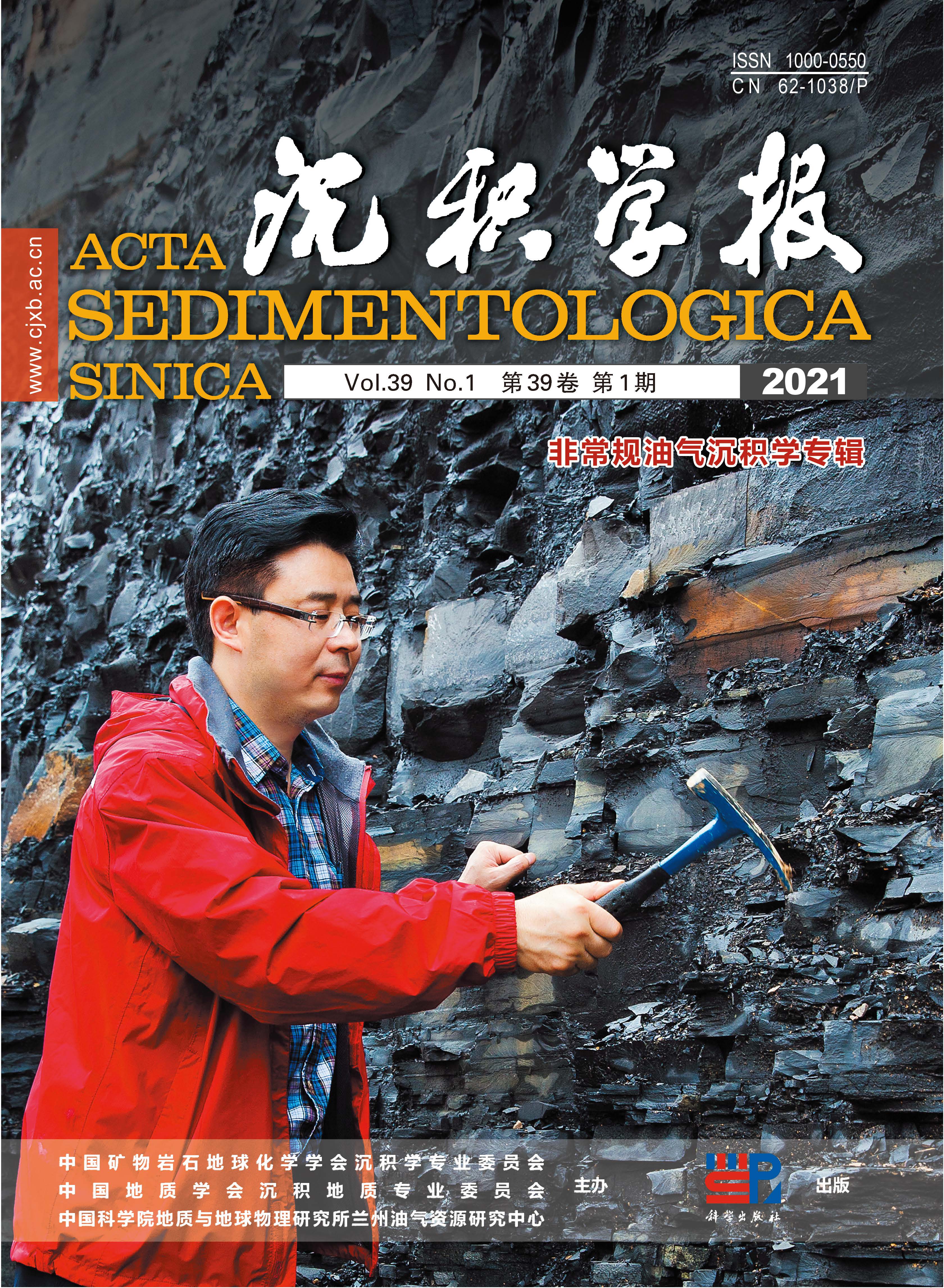


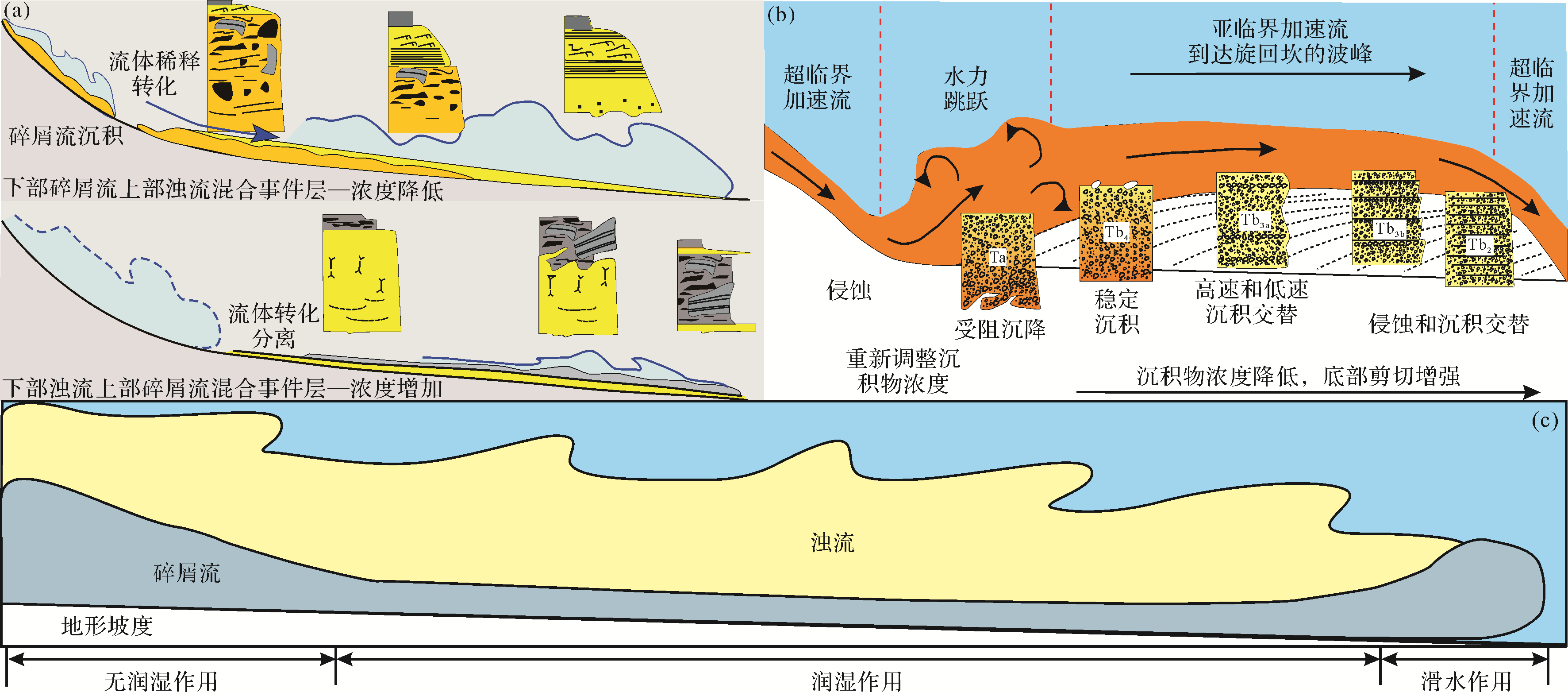










 DownLoad:
DownLoad:


